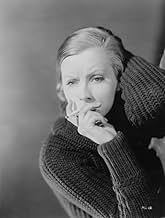Anna Christie
- 1930
- Tous publics
- 1h 29min
NOTE IMDb
6,5/10
3,7 k
MA NOTE
Ajouter une intrigue dans votre langueA young woman reunites with her estranged father and falls in love with a sailor, but struggles to tell them about her dark past.A young woman reunites with her estranged father and falls in love with a sailor, but struggles to tell them about her dark past.A young woman reunites with her estranged father and falls in love with a sailor, but struggles to tell them about her dark past.
- Nommé pour 3 Oscars
- 6 victoires et 3 nominations au total
Histoire
Le saviez-vous
- AnecdotesThis film was the fifth most popular movie at the U.S. box office for 1930.
- GaffesAt about 1 hr 16 min during Garbo's long speech there is a brief unidentifiable noise, possibly off-stage, that was left in the take.
- Citations
Anna Christie: Gimme a whisky, ginger ale on the side, and don't be stingy, baby!
- Versions alternativesTwo versions of this film exist: this English-language version was directed by Clarence Brown, while a simultaneously filmed German-language version was directed by Jacques Feyder. The German version has a different running time and features a different supporting cast.
- ConnexionsAlternate-language version of Anna Christie (1930)
- Bandes originalesIn the Good Old Summertime
(1902) (uncredited)
Music by George Evans
Lyrics by Ren Shields
Played and sung on a gramophone and by Marie Dressler
Commentaire à la une
In New York, the alcoholic skipper of a coal barge Chris Christofferson (George F. Marion) receives a letter from his estranged twenty year old daughter Anna "Christie" Christofferson (Greta Garbo) telling that she will leave Minnesota to stay with him. Chris left Anna fifteen years ago to the countryside to be raised by relatives in a farm in St. Paul and he has never visited his daughter.
Anna Christie arrives and she is a wounded woman with a hidden dishonorable past since she had worked for two years in a brothel to survive. She moves to the barge to live with her father and one night, Chris rescues the sailor Matt (Charles Bickford) and two other fainted sailors from the sea. Soon Anna and Matt fall in love with each other and Anna has the best days of her life. But when Matt proposes to marry her, she is reluctant and also haunted by her past. Matt insists and Anna opens her heart to Matt and to her father disclosing the darks secrets of her past.
"Anna Christie" is the first talkie of Greta Garbo and a heartbreaking story of a young woman that finds redemption through love. I bought the DVD with both versions of 1930 and 1931, and the version in English is restored and has additional scenes in the beginning and in the ending; however, Jacques Feyder's version in German is better than Clarence Brown's. My vote is seven.
Title (Brazil): "Anna Christie"
Anna Christie arrives and she is a wounded woman with a hidden dishonorable past since she had worked for two years in a brothel to survive. She moves to the barge to live with her father and one night, Chris rescues the sailor Matt (Charles Bickford) and two other fainted sailors from the sea. Soon Anna and Matt fall in love with each other and Anna has the best days of her life. But when Matt proposes to marry her, she is reluctant and also haunted by her past. Matt insists and Anna opens her heart to Matt and to her father disclosing the darks secrets of her past.
"Anna Christie" is the first talkie of Greta Garbo and a heartbreaking story of a young woman that finds redemption through love. I bought the DVD with both versions of 1930 and 1931, and the version in English is restored and has additional scenes in the beginning and in the ending; however, Jacques Feyder's version in German is better than Clarence Brown's. My vote is seven.
Title (Brazil): "Anna Christie"
- claudio_carvalho
- 3 nov. 2012
- Permalien
Meilleurs choix
Connectez-vous pour évaluer et suivre la liste de favoris afin de recevoir des recommandations personnalisées
- How long is Anna Christie?Alimenté par Alexa
Détails
Box-office
- Budget
- 376 000 $US (estimé)
- Durée1 heure 29 minutes
- Couleur
Contribuer à cette page
Suggérer une modification ou ajouter du contenu manquant

Lacune principale
By what name was Anna Christie (1930) officially released in India in English?
Répondre

























